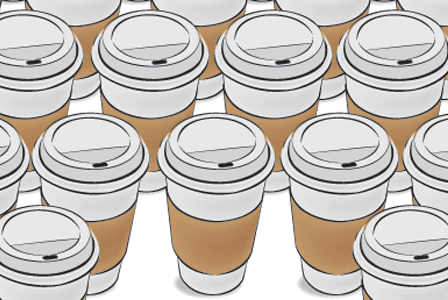
It\’s surprisingly difficult to create a biodegradable paper cup. Many coffee lovers use their own reusable coffee cups. What is the greenest coffee cup choice?
Whether we’re standing on the sidelines cheering for our children or heading to the office, there’s something comforting about bringing along a hot beverage.
These days it’s easy to have our drink and take it too. The only problem is the resulting mountain of disposable cups accumulating in our landfills, and even sometimes on our streets.
Cups in time
In the early days of takeout coffee, we were content with white, spongy polystyrene. (Most of us call it Styrofoam, a name patented by the Dow Chemical Company, which was never actually made into cups.) In the 1980s polystyrene fell into disfavour after reports that it contributed chlorofluorocarbons (CFCs) to the earth’s atmosphere—and CFCs were identified as the substances eating away at our ozone layer.
According to the American Chemistry Council, since 1990 polystyrene products used in food packaging are manufactured without the use of CFCs. Despite this, many consumers still believe polystyrene is the environmental bad guy when it comes to disposable cups.
The problem with paper
The paper coffee cup seemed like an eco-friendly alternative. After all, paper is recyclable. However, paper cups made to hold hot drinks are coated with a plastic that gives it shape, and it’s this coating that not only makes the cups difficult to recycle, it also prevents them from breaking down in the landfill.
Disposable cups can’t be made from recycled paper because, according to Environment Canada, it fails to meet health standards and is not sturdy enough to support liquid.
Study surprises
A University of Victoria study is often quoted in today’s paper-versus-polystyrene debate. The study compares the energy required to manufacture paper and polystyrene cups—environmentalists did a double take at the results.
The study reported that production of polystyrene cups used half as many raw materials and much less energy than did production of paper ones. It pointed out both types take up similar landfill space, and once there, both materials break down equally slowly or not at all.
Many of us believe once a product gets to the landfill, it eventually breaks down. What happens, however, is waste becomes entombed rather than decomposing. As with plastics, when polystyrene eventually does degrade, it turns into tiny particles that can end up in the food chain.
Changing popular belief
A report from McMaster University points out the need for an attitude shift similar to the way in which the use of plastic bags has become uncool. It suggests several strategies to encourage consumers to reduce their cup consumption.
The report recommends cafes should post signage letting patrons know their cup is not recyclable. It advises baristas to ask customers if they require a cup—a reminder there is another option—and to have reusable cups for use or purchase at the point of sale.
The report rejects biodegradable cups as an alternative. It concludes even this option is undesirable because it relies on natural starches, such as corn or potatoes, which could instead be used for food, inflating the prices of these dietary staples. Also, using biodegradables doesn’t change our unsustainable throwaway behaviour.
Baristas take the lead
To combat the negative impact of disposable cups on the environment, some cafes have come up with creative ways to opt out of contributing to landfill overload.
Caffiends, a student-run, nonprofit cafe at the University of Toronto, has gone a step further by eliminating paper cups all together. Vanessa Guidorizzi, Caffiends co-manager, says most of her customers bring in their own mugs, and those without are happy to pause for the short while it takes to finish their tea or coffee in a reusable mug.
Guidorizzi believes the no-disposables approach is feasible in for-profit businesses. “I think it’s completely doable because the mentality is changing; people are looking to be more environmentally friendly, so people do have their own cups, or are willing to take the time to sit down and have their cup of coffee.”
Time, or lack of it, seems to be the main driver behind our takeout and wasteful ways. However, taking a few minutes for a stay-in tea or coffee may, in the end, add more than a jolt of caffeine to our day. It may provide just a short oasis of time where we can slow down and take a breather. And if we really can’t pause, a reusable mug is the best solution for taking away that beverage.
Stacking up the paper cup
|
| Giving up the paper cup
Reusable drinking containers last for years, so you’ll want to choose one you’ll enjoy day after day. Thanks to Canadian regulations, we don’t have to worry about lead contamination from ceramic or glass cups. Be wary of those purchased in countries that may not follow the same guidelines. If you like the takeaway look, you can purchase an “I am not a paper cup,” a ceramic mug that looks just like a paper one, complete with reusable silicone lid. escience.ca. If you’re choosing a plastic reusable mug, be sure to check the recyclable number on the bottom. According to National Geographic’s Green Guide, those with the numbers 2, 4, and 5 will not release substances into your food and can be recycled in most municipalities. If you prefer metal, choose one without a liner, since some epoxy liners contain the unhealthy chemical bisphenol A. |



